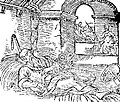Saint Himelin | |
|---|---|
 | |
| Died | c. 750 Vissenaken (Tienen) |
| Venerated in | Roman Catholic Church, Orthodox Church |
| Major shrine | Vissenaken |
| Feast | March 10 |
| Attributes | Depicted as a pilgrim, with a staff; or ill in bed |
Saint Himelin (Hymelin, Himelinus) (died Vissenaken, c. 750 AD) was an Irish [1] or Scottish [2] priest who, returning from a pilgrimage to Rome, fell ill when passing through Vissenaken (in present-day part of the municipality Tienen in Belgium). [3]
He is said to have been the brother of Rumbold, patron saint of Mechelen. [1]
The legend of Saint Himelin states that in Vissenaken he asked a girl for some water. She refused, as there was bubonic plague in the area. However, after much insistence from Himelin, she finally gave him a pitcher of water, which miraculously turned into wine. Himelin died three days later of the plague. He is venerated on 10 March. His cult is confined to Vissenaken. [2]


